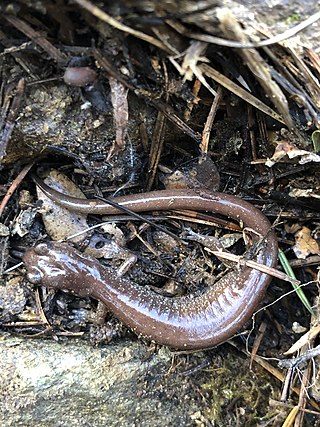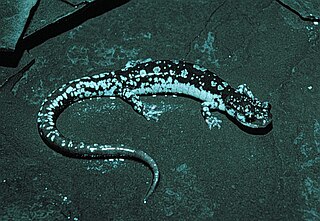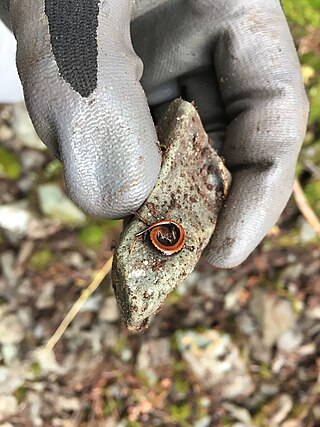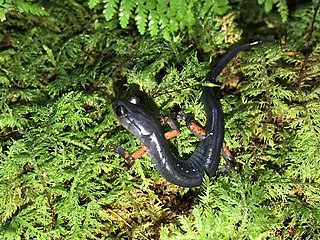
Plethodon is a genus of salamanders in the family Plethodontidae. They are also known as woodland salamanders or, more rarely, slimy salamanders. All members of the genus are endemic to North America. They have no aquatic larval stage. In some species, such as Plethodon cinereus, the red-backed salamander, eggs are laid underneath a stone or log. Young hatch in the adult form. Members of Plethodon primarily eat small invertebrates. The earliest known fossils of this genus are from the Hemphillian of Tennessee in the United States.

The northern slimy salamander is a species of terrestrial plethodontid salamander found throughout much of the eastern two-thirds of the United States.

Van Dyke's salamander is a small woodland salamander in the family Plethodontidae, the lungless salamanders. These animals breathe through their skin and are largely terrestrial. Compared to other salamanders in Plethodon it is relatively stocky with long legs. Usually associated with streams, seepages, and rock outcrops, it is endemic to Washington where it is found in a limited number of small, isolated populations.

The Scott Bar salamander is a species of salamander in the family Plethodontidae, endemic to the United States, where it is restricted to a very small range in the Scott River drainage in Siskiyou County, California, at altitudes between 700 and 1,300 metres above sea level. Described in 2005, it is one of the most recently described species in the large genus Plethodon.

The Cheoah Bald salamander is a species of salamander in the family Plethodontidae endemic to the state of North Carolina in the United States. Its natural habitat is temperate forests and it is threatened by habitat loss. It was formerly considered a variant of the red-cheeked salamander until it was found to be a distinct species.

Dunn's salamander is a species of salamander in the family Plethodontidae endemic to the western United States.

The Del Norte salamander is a species of salamander in the family Plethodontidae endemic to the United States in southwestern Oregon and northwestern California.

The Fourche Mountain salamander is a species of salamander in the family Plethodontidae endemic to the Ouachita Mountains in the central United States. Its natural habitat is temperate forests and it is threatened by habitat loss.

The red-cheeked salamander, also known as the Jordan's salamander, Jordan's redcheek salamander, or Appalachian woodland salamander, is a species of salamander in the family Plethodontidae. It is endemic to the Appalachian Mountains in the southeastern United States.
The Kiamichi slimy salamander is a species of salamander in the family Plethodontidae endemic to the United States, has a natural habitat of temperate forests, and is found over a small range. This nocturnal species is mainly threatened by habitat loss and was first described by Highton in 1989. It is rated as a vulnerable species by the International Union for Conservation of Nature.

The Larch Mountain salamander is a species of salamander in the family Plethodontidae endemic to the United States. It occurs in the Cascade Mountains of southern Washington and northern Oregon. In Washington, it occurs from the Columbia River Gorge to just north of Snoqualmie Pass. Its natural habitats are temperate forests and rocky areas. It is threatened by habitat loss.
The South Mountain gray-cheeked salamander is a species of salamander in the family Plethodontidae, endemic to the state of North Carolina in the United States, where it is only found in the South Mountains. It was formerly considered a variant of the red-cheeked salamander. Its natural habitat is temperate forests. It is threatened by habitat loss.

The northern gray-cheeked salamander is a species of salamander in the family Plethodontidae and endemic to the Blue Ridge Mountains and Appalachian Mountains in the eastern United States. It is closely related to the Red-cheeked salamander and the Red-legged salamander. Its natural habitat is temperate forests. It is found under moss, rocks, logs, and bark in cool, moist forests above 2500 feet. Especially found in spruce-fir forests. The Gray-cheeked Salamander commonly eats millipedes, earthworms, crane flies, spiders, and centipedes and less commonly eats ants, mites, and springtails. They eat spiders, moths, flies, beetles, bees, and snails. The male and female perform a courtship, where the male nudges the female with his snout, does a foot dance, then circles under the female and the two then walk together. Like other salamanders, they do not migrate or aggregate during breeding season. It is threatened by habitat loss.

The Rich Mountain salamander is a species of salamander in the family Plethodontidae. It is endemic to the Ouachita Mountains in western Arkansas and eastern Oklahoma. Its natural habitat is temperate forests. It is threatened by habitat loss.

Plethodon punctatus, commonly known as the Cow Knob salamander or white-spotted salamander, is a species of salamander in the family Plethodontidae. It is endemic to high mountain forests on the border of Virginia and West Virginia in the United States. Nearly all occurrences are on Shenandoah Mountain, Nathaniel Mountain and Great North Mountain in George Washington National Forest. Cow Knob salamanders are a member of the P. wehrlei species complex, which includes many other Appalachian salamanders historically referred to Plethodon wehrlei.
The Sequoyah slimy salamander is a species of salamander in the family Plethodontidae.

The Shenandoah salamander is a small, terrestrial salamander found exclusively in Shenandoah National Park in Virginia. The Shenandoah salamander inhabits a very small range of land on just three mountain peaks. Due to the small habitat range, interspecies competition, and climate change, the population of the Shenandoah salamander is vulnerable to extinction. Mitigating human effects on the habitat of the species will be essential in attempting to preserve and grow the population.

The red-legged salamander is a species of salamander in the family Plethodontidae. Formerly considered a subspecies of Plethodon jordani, it is native to the mountain forests of the southeastern United States.

The western red-backed salamander is a species of salamander in the family Plethodontidae. The species is found in extreme southwestern Canada and the northwestern United States. The western red-backed salamander is found in temperate rainforests of the Pacific Northwest. It is considered widespread in the region and is not strictly associated with a specific habitat type.

















